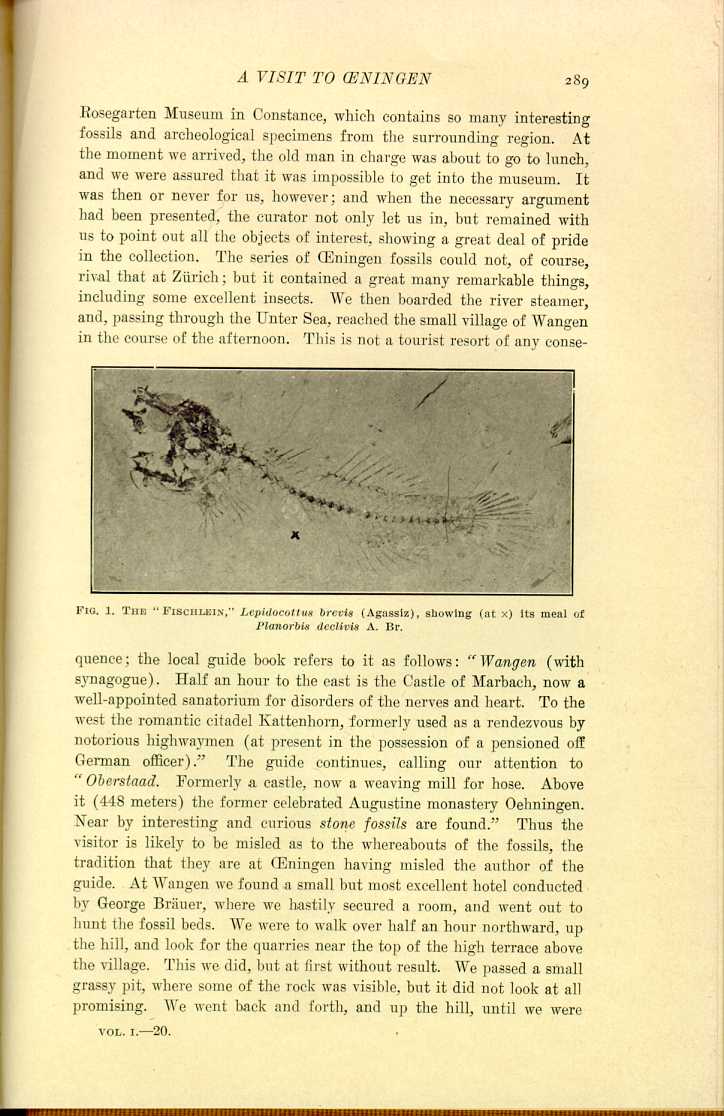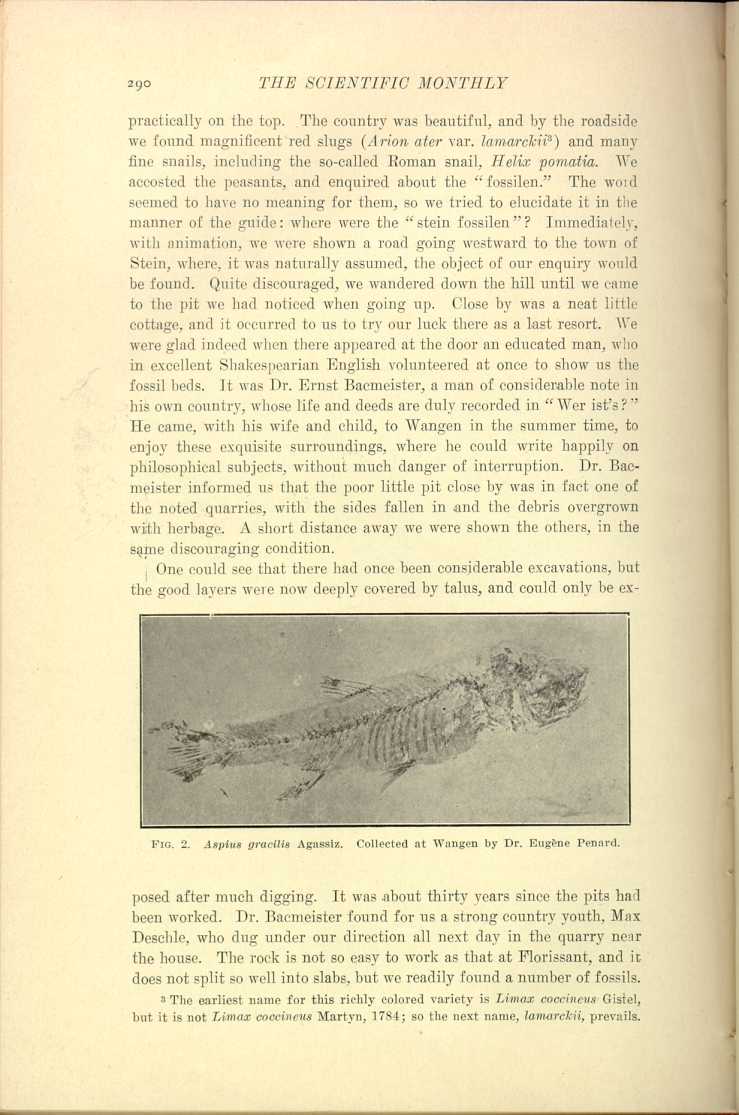| The Scientific Monthly | ||
A VISIT TO ŒNINGEN
BY PROFESSOR T. D. A. COCKERELL
UNIVERSITY OF COLORADO
AS the Rhine broadens on its approach to the Lake of Constance or Boden Sea it flows through a region made classic by the researches of scientific men. Here at low tide it is sometimes possible to see wooden piles which in prehistoric times supported the houses of the lake-dwelling folk, whose work is so well represented in various museums, especially at Zürich. From the river, on each side, the land rises rapidly, and the rounded summits of the hills are well wooded. It is on the left side of the Rhine, about two and a half miles below the town of Stein, that we come to the famous locality for Miocene fossils, the European representative of our Florissant in Colorado.
In all the books the fossil beds are said to be at Œningen, which is the name of a once celebrated Augustinian monastery about two miles away. Actually, however, the locality is above the village of Wangen, which is situated on the north bank of the river. In some quite recent writings Œningen (Wangen) is referred to as being in Switzerland; it is in Baden, though the opposite bank of the Rhine is Swiss. The error is natural, since the fossils have chiefly been made known by the great Swiss paleontologist Heer, of Zürich, and the best general account of them is to be found in his book "The Primæval World of Switzerland,'' of which an excellent English translation appeared in 1876.
It was at the Œningen quarries, in the eighteenth century, that a wonderful vertebrate fossil, some four feet long, was discovered. A writer of that period, Scheuchzer, announced it as >Homo diluvii testis, a man witness of the deluge! Cuvier knew better, and was able to demonstrate its relationship to the giant salamanders of Eastern Asia and North America. It forms, in fact, a distinct genus of Cryptobranchidæ, which Tschudi, apparently mindful of the early error, named Andrias; though the proper name of the animal appears to be Proteocordylus scheuchzeri (Holl.). The stone at Wangen was used for building purposes, and at one time there were three or four quarries actively worked. In earlier times the larger fossils naturally attracted most attention, fishes, snakes, trutles, fresh-water clams and a variety of leaves and fruits. Such specimens were saved, and were sold and distributed to many museums. The supply was good, yet at times not sufficient for the market; so the monks at Œningen, and others, would carve artificial fossils out of the soft rock, coating them with a brown stain prepared from unripe walnut shells. In later years, during the middle part of the nineteenth century, the period of Darwin, the great importance and interest of the fossil beds came to be better appreciated. Dr. Oswald Heer, professor at Zürich, an accomplished botanist and entomologist,
From 1847 to 1853 Heer published in three parts a great work on fossil insects, largely concerned with those from Œningen.[1] In this and later writings he made known 464 species from this locality; but in the latest edition of "The Primæval World of Switzerland'' it is stated that there are 844 species, 384 of these being supposedly new, and named, if at all, only in manuscript.
My wife and I, having worked a number of years at Florissant, were very anxious to see the corresponding European locality for fossil insects. The opportunity came in 1909, when we were able to make a short visit to Switzerland after attending the Darwin celebration at Cambridge. We went first to Zürich, where in a large hall in the University or Polytechnicum we saw Heer's collections. A bust of Heer stands in one corner, while one end of the room is covered by a large painting by Professor Holzhalb, representing a scene at Œningen as it may have appeared in Miocene times, showing a lake with abundant vegetation on its shores, and appropriate animals in the foreground. Numerous glass-covered cases contain the magnificent series of fossils, both plants and animals. Dr. Albert Heim, professor of geology and director of the Geological Museum, was most kind in showing us all we wanted to see, and giving advice concerning the precise locality of the fossil beds. Professor Heim is an exceedingly active and able geologist, but neither he nor any one else has continued the work of Heer, whose collections remain apparently as he left them. The 384 supposedly new insects are still undescribed, with a few possible exceptions. I had time only to critically examine the bees, of which I found three ostensibly new forms. Of these, one turned out to be a wasp, [2] one was unrecognizable, but the third was a valid new species, and was published later in The Entomologist. There can be no doubt that Heer was too ready to distinguish species of insects in fossils which were so poorly preserved as to be practically worthless, consequently part of those he published and many of those he left unpublished will have to be rejected. Nevertheless, the Œningen materials are extremely valuable, both for the number of species and the good preservation of some of them. All should be carefully reexamined, and the entomologist who will give his time to this work will certainly be rewarded by many interesting discoveries.
Provided with instructions from Professor Heim, we started on August 4 for Wangen, going by way of Constance. Thanks to the map furnished by the Swiss railroad, we had no difficulty in finding the

FIG. 1. THE "FISCHLEIN,'' Lepidocottus brevis (Agassiz), showing (at x) its meal of Planorbis declivis A. Br.
[Description: Photograph of a fish-like stone fossil. A head (facing left), vertebra and tail are clearly visible.]One could see that there had once been considerable excavations, but
the good layers were now deeply covered by talus, and could only be
exposed

FIG. 2. Aspius gracilis Agassiz. Collected at Wangen by Dr.
Eugène Penard.
[Description: Photograph of a fish-like stone fossil. A head (facing right),
vertebra and tail are clearly visible.]
We left Wangen on the morning of August 6, and proceeded up the Rhine to Schaffhausen and Basle. At Basle we found a certain number of Œningen (Wangen) fossils in the museum.
Comparing Wangen with Florissant, it appears that the Colorado locality is more extensive, more easily worked, and provides many more well-preserved fossils. On the other hand, Wangen has proved far richer in vertebrates and crustacea, and on the whole gives us a better idea of the fauna as it must have existed. Florissant far exceeds Wangen in the number of described species, but this is only because it has so many more insects. Each locality furnishes us with extraordinarily rich materials, enabling us to picture the life of Miocene times. Each, by comparison, throws light on the other, and while the period represented is not sufficiently remote to show much evidence of progressive evolution, it is hard to exaggerate the value of the facts for students of geographical distribution. Much light may also be thrown on the relative stability of specific characters.
Work on the Florissant fauna is going forward, though not so fast as one could wish. It is very much to be hoped that the Wangen quarries will receive attention before many years have passed. Labor is comparatively cheap in Germany, and with a force of a dozen men it would not take long to open up the quarries and get at the best beds. It is really extraordinary that no one has seen and taken advantage of the opportunities presented. Probably no obstacles of any consequence would be put in the way; at least the owner of the quarries came by when we were digging, and expressed only his good will. With new researches in the field, combined with studies of the rich materials awaiting examination at Zürich and elsewhere, no doubt the knowledge we possess of the European Miocene fauna could be very greatly increased, to the advantage of all students of Tertiary life.
| The Scientific Monthly | ||